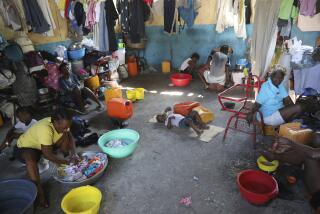Malnutrition Takes a Toll on Argentina
- Share via
GARUPA, Argentina — Her dark, sunken eyes stare at the steam wafting from a pot of beans and noodles. For Fabiana Casapava, 12, the watery gruel will be her only meal of the day.
Fabiana and her six siblings have been coming to a community soup kitchen for their daily sustenance the last two years.
Set in the sweltering Misiones province, her town of Garupa, 685 dusty miles northeast of Buenos Aires, is home to 32,000 people, most of whom are struggling to make ends meet.
Scrawny and underweight, Fabiana complains often of being hungry. It’s an ugly reflection of the times in a once-wealthy South American country crippled by a four-year recession.
Argentina prides itself as being one of the world’s great food baskets, but rising food prices and unemployment caused by the protracted slump have spread hunger across a country famous for fork-tender beef and unending fields of grain.
The fiery red soil and verdant jungle around Garupa, in Argentina’s remote northeast corner, make for fertile tea and tobacco plantations -- but little else. Even those fields stand barren, victims of the economic turmoil. About 65% of the town’s people live in poverty and 70% of the children are undernourished.
Fabiana’s parents are unemployed; she rarely eats at home.
“In the morning, I drink milk at school. But when there are no classes, I have no breakfast,” she says. “At home, sometimes we eat dinner, and other times nothing, or just tea and bread.”
Children are dying or falling ill from hunger not only in Misiones and the traditionally poorer north but also in some of Argentina’s richest provinces, such as the industrial region around Buenos Aires, the capital.
Ulises Soto, a physician who provides medical assistance for those who come to Garupa’s soup kitchen, says malnutrition has become all too common. “You are out walking on the street and see children who are obviously malnourished. Their stomachs are bloated, their legs frail ... their eyes sunken.” Many parents are unemployed, the families barely scraping by on handouts and odd jobs. Houses are no more than huts built of wood, straw and canvas. As many as 14 people in an extended family can be found crowded into a single dwelling.
“My dad works but he doesn’t make enough to provide for us, so sometimes there is no food,” says Maria Rosa Barrios, 8, as she eagerly downs bread and jam at the soup kitchen. She has walked 50 blocks from home for her only meal of the day.
Although the government keeps no statistics on hunger, a study led by the University of Buenos Aires and the Society of Pediatricians estimates the nation of 37 million people is seeing an average of 27 children under 5 die daily from causes related to malnourishment.
Many more are at risk, like Gustavo, 18 months. He weighs 13 pounds, far below average for a child his age. Oblivious to his mother’s efforts to console him, the hungry infant sobs in the waiting room of the only hospital in Obera, about 75 miles east of Garupa. “To see your child like this makes you desperate,” says the mother, Fabiana Bianchi. “Each day Gustavo was getting worse, to the point he was only skin and bones.”
More to Read
Sign up for Essential California
The most important California stories and recommendations in your inbox every morning.
You may occasionally receive promotional content from the Los Angeles Times.













